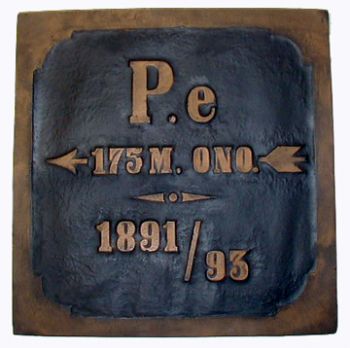
This is a direct resin casting of the bronze plaque found at the famous Trinil or Java Man site. Trinil is a palaeoanthropological site on the banks of the Bengawan Solo River in Ngawi Regency, East Java Province, Indonesia. It was at this site in 1891 that the Dutch anatomist Eugene Dubois discovered the first early hominid remains to be found outside of Europe: the famous "Java Man" specimen.
Translated it says: Pithecanthropus erectus was found 175 meters east-north-east of this spot in the years 1891/1893.
Java Man (Homo erectus erectus) is early human fossils discovered on the island of Java (Indonesia) in 1891 and 1892. Led by Eugène Dubois, the excavation team uncovered a tooth, a skullcap, and a thighbone at Trinil on the banks of the Solo River in East Java. Arguing that the fossils represented the "missing link" between apes and humans, Dubois gave the species the scientific name Anthropopithecus erectus, then later renamed it Pithecanthropus erectus.
The fossil aroused much controversy. Less than ten years after 1891, almost eighty books or articles had been published on Dubois's finds. Despite Dubois's argument, few accepted that Java Man was a transitional form between apes and humans. Some dismissed the fossils as apes and others as modern humans, whereas many scientists considered Java Man as a primitive side branch of evolution not related to modern humans at all. In the 1930s Dubois made the claim that Pithecanthropus was built like a "giant gibbon", a much-misinterpreted attempt by Dubois to prove that it was the "missing link".
Eventually, similarities between Pithecanthropus erectus (Java Man) and Sinanthropus pekinensis (Peking Man) led Ernst Mayr to rename both Homo erectus in 1950, placing them directly in the human evolutionary tree. To distinguish Java Man from other Homo erectus populations, some scientists began to regard it as a subspecies, Homo erectus erectus, in the 1970s. Other fossils found in the first half of the twentieth century in Java at Sangiran and Mojokerto, all older than those found by Dubois, are also considered part of the species Homo erectus. Estimated to be between 700,000 and 1,000,000 years old, at the time of their discovery the fossils of Java Man were the oldest hominin fossils ever found. The fossils of Java Man have been housed at the Naturalis in the Netherlands since 1900.
http://en.wikipedia.org/wiki/Trinil
resin
15x15 inches
Item 1361
Category: Replicas
Type: Wall Plaques
Phylum: Vertebrates
Class: Hominids & Humans
MORE PHOTOS:


Now Over 1,000 Items!
PrehistoricStore.com offers the largest selection of replica fossils and other fossil-related products anywhere in the world!
Download a Full Catalog (3MB PDF)
OVER 260 PAGES OF REPLICAS AND MORE!
